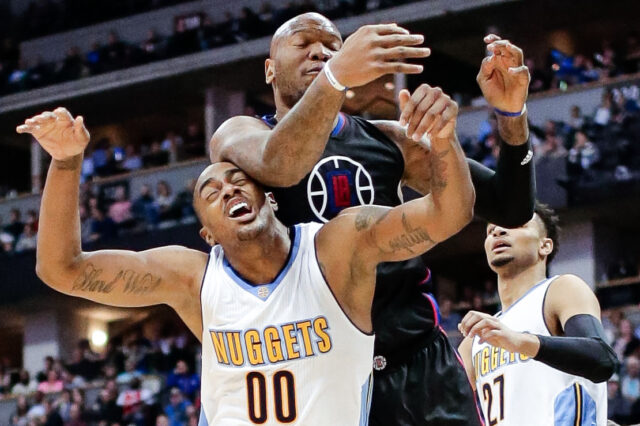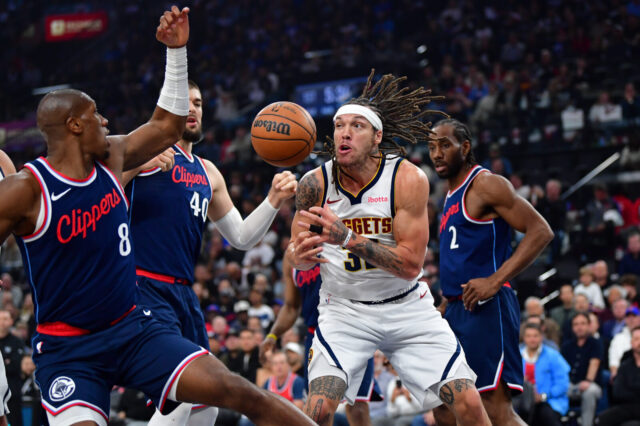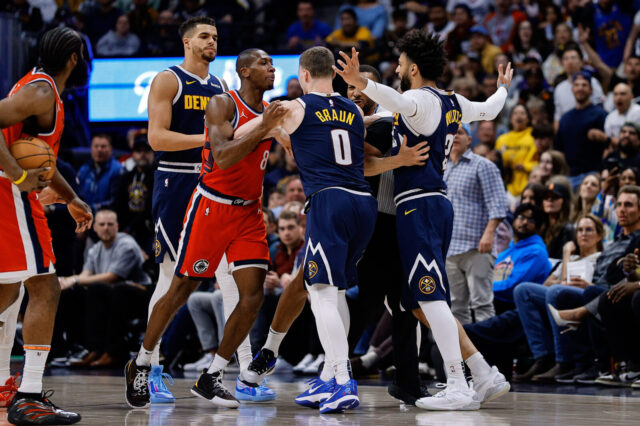The biggest breakthrough for the Denver Nuggets last season was the development of Nikola Jokic. His breakout season helped create what was widely assumed to be the team’s offensive identity going forward. Much like Doug Moe’s teams of the 1980s, the new-look Nuggets appeared to be crafting a unique, fast-paced and very efficient style of offense that relied on ball movement, led by one of the most unique players in the league.
There were clear obstacles facing the team as they moved into phase two of their ascent towards making the playoffs and, ultimately, title contention. They needed to shore up their defense, add more playmakers, learn how to score in the clutch, and clarify their rotation but the offensive identity seemed to be worked out.
In theory, Paul Millsap fit right into that equation. He’s an unselfish all-star who is just as willing to pass as he is to shoot, he has a high basketball IQ, and he could single-handedly elevate the defense. Through the first week of the season, the early returns have been mixed. Denver’s defense looks much better in nearly every facet but the offense has taken a huge step back. The team ranks 18th in offensive rating (ORTG), often looking clunky and disjointed and rarely finding more than a few short bursts of the firepower that the team displayed for four straight months to end last season.
This shouldn’t be too surprising. Even players who fit perfectly on paper still require time to gel and figure out the tendencies, preferences, and personalities of their teammates. The team will likely figure things out at some point but what exactly does will that look like? If Jokic is the cornerstone for which the team is building around, how can Millsap fit into the Jokic-led offense in a way that utilizes both of their talents? Let’s take a closer look in this week’s spotlight.
This content is no longer available.
As I wrote last season, Kenneth Faried provides one blueprint for how to play alongside Jokic. Faried is a low usage player who’s offensive output primarily comes from putback dunks and dropoffs. His above-the-rim athleticism and knack for dragging his defender away from the paint provides the perfect balance to Jokic’s wizardry at the elbows and the top of the key. It is that combination of skills that led the Jokic-Faried frontcourt to an eye-popping 124 ORTG and a team-high Net Rating (NetRTG) of 11.8 last season.
Millsap is a much more versatile and skilled player than Faried but he is also still figuring out the spacing, rhythm, and timing that Faried has perfected next to Jokic. In Denver’s base offense last season, Jokic would hunt for dribble handoffs (DHO) and pick and rolls (PnR) around the arc. Typically, the power forward would anticipate that action and vacate the ball side to open cutting lanes, allowing Jokic to go from one screen to the next, sometimes four or five times in one possession until a shot opened up.
Faried doesn’t touch the ball on that play but he is still makes a huge impact. He has the willingness to play this way every second that he is on the court with Jokic, in part because his skill set is more narrow. Millsap is not as comfortable playing decoy, nor should he be, but he is going to have to pick spots where he does his best Faried immiation.
In the clip below, Millsap’s instinct is to head for the block when the ball reverses, trying to establish position for a post up. However, on the reversal Gary Harris finds what would typically be a cutting lane The result is clunky spacing that both blocks the cut and walls off a post up opportunity.
On a nearly identical possessions, Millsap properly anticipates the cut but doesn’t drag his defender far enough away from help side and isn’t able to make himself available for the easy dropoff. The reason for this partially because Millsap isn’t deep enough in the dunker’s spot to pull his defender away but part of it is that he isn’t quite the explosive dunk threat that Faried is.
But what makes Millsap even more dynamic than Faried is his feel for how to open up shots for teammates off ball. One of the best plays of the preseason appeared to happen by accident. Watch how perfectly timed Millsap’s screen is on the weak side that opens up a skip pass and roll. This is the type of offensive action that was envisioned when Millsap was brought in. Whereas Faried can space the floor becasue of his athleticism and the threat he provides on the boards, Millsap could open up the paint by virtue of his shot, his passing, his ability to attack a scrambled defense, and most of all, his ability to make smart reads on the weak side that will open up plays for teammates.
You can see how Millsap is slow to recognize just how effective that back screen was at moving the defense. As Jokic forces the defense to react on the left side, LaMarcus Aldridge and Dejounte Murray are out of position for that weak side screen and are even more out of position for Millsap’s roll to the rim.
It’s ironic that this action happened against the Spurs, perhaps the league’s best team at anticipating weak side screens to scramble the defense before the reversal. One of the best ways that Millsap can involve himself in the Jokic offense is to hunt for these weak side screens. Becoming a weak side honing missile for screens and perfecting the timing and positioning for these types of screens opens up a whole new wrinkle for Denver’s offense.
Jokic also has to adjust to Millsap. Another way that the duo can punish teams when they share the court is through creating and exploiting mismatches. Too much hunting for switches and mismatches through isolations can be a mistake but in moments when the flow of the offense leads to opportunities to attack mismatches off of the catch, both guys will have to quickly read each other.
In the clip below, a pindown action creates mismatches for both players. Jokic gets the undersized Carmelo Anthony in the post and Millsap gets the slow-footed Steven Adams out on the wing. Both guys have favorable match-ups, but Jokic needs to read Millsap’s drive quicker and get out of the way.
The best way to quicken their response time is to continue playing together. Experience and repetitions will help the two anticipate each other much more quickly. Eventually, Jokic will know that Millsap likes to drive in those situations and he can begin working to open up the paint for him or open up shooters on the weak side with sneaky back screens.
Fortunately, even the sub-optimal chemistry between Jokic and Millsap is bringing solid results. In 65 minutes, the Nuggets have outscored opponents by 7 points, thanks in large part to a very stingy 95.0 DRTG. Once the offensive chemistry with those two improves, the sky is the limit for the damage those two can unleash. For now, the two will have to slog through these uncomfortable growing pains until they figure each other out.
This content is no longer available.
One reason the Jokic offense works is because it forces the defense to fight through multiple DHOs and PnRs in the same possession, often times in quick succession. In this clip, the Nuggets find three ball screen opportunities before finally forcing a guard to switch onto Jokic in the post. From there, Jokic reads the defense and finds the open man. Jamal Murray passes up one open shot but even with that mistake, the effects of those early ball screens still causes the defense to scramble. The ball ultimately finds a wide open Millsap under the basket. Notice once again that Millsap was not involved on the play until the end. This is the sacrifice that has to be made on some possessions in order to allow Jokic to do his thing.
Millsap makes so many really smart plays on defense. This one in the Washington game stood out. As the shot clock wound down to 5 seconds, Millsap realized that his man became less of a threat and John Wall driving into the paint became more of a threat, so he hops over into the paint before Wall even starts to make his drive. He anticipated that Wall’s options were dwindling and took away his best remaining option. It’s a little thing but it’s something only guys like Millsap routinely make.
It’s interesting seeing Millsap in spots on offense that are typically reserved for wing players. The two clips below both feature very common NBA double pindown sets, typically referred to as “elbow strong” and “handoff strong,” respectively. Usually having a player run off of the pindowns drags the defense over the screens but with Millsap, teams just go under, knowing he has a slow release and a low FG percentage from deep. I’m not sure what the aim is of sets like this but it is probably just something I am missing.
This was a near perfect fast break. Jokic runs point, Wilson Chandler sprints toward the corner getting behind the line of site of the defense before cutting toward the rim. Faried cuts down the lane for the slam. This is when the Nuggets are at their most fun.
This content is no longer available.
24.0
That’s the average number of points per game Denver is allowing off of turnovers, the 3rd worst mark in the NBA. Denver will enter Wednesday’s game with the 10th ranked defense but that ranking could easily be much higher if they weren’t spotting teams so many points off of turnovers. According to one of my favorite sites, stats.inpredictable.com, Denver has the 11th best defense following a made basket and the 6th best defense following a defensive rebound.
Turnovers are going to happen in Denver’s pass-happy offense but half of their turnovers this year are easily avoidable. It’s also possible that the high turnover rate is the result of guys being unsure of what to do on offense. It’s an encouraging sign since Denver is thisclose to having a very solid defense if they can just limit possessions where they have no chance to get back and defend.
This content is no longer available.
Will Barton | DEN @ UTA | 23 points, 6 rebounds, 2 assists
Denver’s offense struggled against the stingy Jazz defense but Barton helped the Nuggets look competent for much of the first half thanks to some hot shooting and fancy playmaking. He cooled off down the stretch but so did everyone wearing Nuggets blue. Barton has solidified himself as an irreplaceable member of the team and arguably the team’s best one-on-one scorer.
Kenneth Faried | SAC @ DEN | 18 points, 8 rebounds, 7-10 FG
The Manimal was unleashed on Sacramento. Malone seems to have settled into a rotation that allows Faried just two, 6-minute stretches, one to start the 2nd quarter and one to start the 4th. Faried has taken advantage of those minutes, especially against Sacramento where he was everywhere. He even made plays on the defensive end including a block that he jumped at least 12 feet in the air to snag.
Nikola Jokic | WAS @ DEN | 29 points, 9 rebounds, 5 assists
After passing up shots left and right in the previous two games, Jokic came out firing against Washington and dropped 29 points, hitting shots from every spot on the floor. He did have 7 ugly turnovers but he was still the best player on the floor for most of the night.


